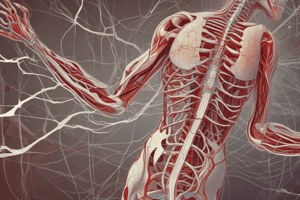Podcast
Questions and Answers
What function does the sympathetic nervous system (SNS) primarily support?
What function does the sympathetic nervous system (SNS) primarily support?
- Sleep
- Fight or flight (correct)
- Energy storage
- Rest and digest
What does the parasympathetic nervous system (PNS) promote?
What does the parasympathetic nervous system (PNS) promote?
- Energy storage formation (correct)
- Smooth muscle contraction
- Increased heart rate
- Stress response
What are the two main divisions of the autonomic nervous system?
What are the two main divisions of the autonomic nervous system?
Sympathetic Nervous System (SNS) and Parasympathetic Nervous System (PNS)
Norepinephrine (NE) inhibits smooth muscle contraction.
Norepinephrine (NE) inhibits smooth muscle contraction.
The neurotransmitter released by the parasympathetic nervous system is called ______.
The neurotransmitter released by the parasympathetic nervous system is called ______.
Which of the following neurotransmitters stimulates smooth muscle contraction?
Which of the following neurotransmitters stimulates smooth muscle contraction?
What is the effect of SNS stimulation on smooth muscle function?
What is the effect of SNS stimulation on smooth muscle function?
What does PNS stimulation do to smooth muscle contraction?
What does PNS stimulation do to smooth muscle contraction?
Which neurotransmitter stimulates contraction of smooth muscle?
Which neurotransmitter stimulates contraction of smooth muscle?
Which of the following neurotransmitters relax smooth muscle? (Select all that apply)
Which of the following neurotransmitters relax smooth muscle? (Select all that apply)
Norepinephrine (NE) relaxes smooth muscle.
Norepinephrine (NE) relaxes smooth muscle.
What is the primary role of Vasoactive Intestinal Polypeptide (VIP)?
What is the primary role of Vasoactive Intestinal Polypeptide (VIP)?
_______ is a neurotransmitter that relaxes vascular smooth muscle.
_______ is a neurotransmitter that relaxes vascular smooth muscle.
Match the following neurotransmitters with their primary action:
Match the following neurotransmitters with their primary action:
Flashcards are hidden until you start studying
Study Notes
Autonomic Nervous System
The autonomic nervous system (ANS) plays a crucial role in the nervous control of smooth muscle. The ANS is a branch of the nervous system that regulates involuntary actions, such as heart rate, digestion, and smooth muscle contraction.
Divisions of the ANS
The ANS consists of two main divisions:
- Sympathetic Nervous System (SNS): responsible for the "fight or flight" response, which prepares the body for physical activity. The SNS stimulates smooth muscle contraction, increases heart rate and blood pressure, and promotes energy storage breakdown.
- Parasympathetic Nervous System (PNS): responsible for promoting relaxation and reducing stress. The PNS inhibits smooth muscle contraction, decreases heart rate and blood pressure, and promotes energy storage formation.
Neurotransmitters
The ANS uses neurotransmitters to transmit signals to smooth muscle cells. The main neurotransmitters involved in the ANS are:
- Acetylcholine (ACh): released by the PNS, ACh inhibits smooth muscle contraction and promotes relaxation.
- Norepinephrine (NE): released by the SNS, NE stimulates smooth muscle contraction and increases heart rate and blood pressure.
Effects on Smooth Muscle
The ANS has a significant impact on smooth muscle function:
- SNS stimulation: increases smooth muscle contraction, leading to increased blood pressure, heart rate, and digestion.
- PNS stimulation: decreases smooth muscle contraction, leading to decreased blood pressure, heart rate, and digestion.
Overall, the autonomic nervous system plays a critical role in regulating smooth muscle function, and imbalance or dysfunction in the ANS can lead to various disorders and diseases.
Autonomic Nervous System
- Regulates involuntary actions, such as heart rate, digestion, and smooth muscle contraction.
Divisions of the ANS
- Consists of two main divisions: Sympathetic Nervous System (SNS) and Parasympathetic Nervous System (PNS).
- Sympathetic Nervous System (SNS): responsible for the "fight or flight" response, which prepares the body for physical activity.
- Parasympathetic Nervous System (PNS): responsible for promoting relaxation and reducing stress.
Neurotransmitters
- Uses neurotransmitters to transmit signals to smooth muscle cells.
- Main neurotransmitters involved:
- Acetylcholine (ACh): released by the PNS, inhibits smooth muscle contraction and promotes relaxation.
- Norepinephrine (NE): released by the SNS, stimulates smooth muscle contraction and increases heart rate and blood pressure.
Effects on Smooth Muscle
- SNS stimulation: increases smooth muscle contraction, leading to increased blood pressure, heart rate, and digestion.
- PNS stimulation: decreases smooth muscle contraction, leading to decreased blood pressure, heart rate, and digestion.
- Imbalance or dysfunction in the ANS can lead to various disorders and diseases.
Neurotransmitters
Excitatory Neurotransmitters
- Acetylcholine (ACh) stimulates contraction of smooth muscle
- Norepinephrine (NE) stimulates contraction of smooth muscle, particularly in vascular and intestinal smooth muscle
- Substance P stimulates contraction of smooth muscle, especially in gastrointestinal and urinary tracts
Inhibitory Neurotransmitters
- Vasoactive Intestinal Polypeptide (VIP) relaxes smooth muscle, especially in gastrointestinal and respiratory tracts
- Nitric Oxide (NO) relaxes smooth muscle, especially in vascular smooth muscle
- Adenosine Triphosphate (ATP) relaxes smooth muscle, especially in gastrointestinal and urinary tracts
Non-Adrenergic, Non-Cholinergic (NANC) Transmitters
- Nitric Oxide (NO) relaxes smooth muscle, especially in vascular smooth muscle
- Carbon Monoxide (CO) relaxes smooth muscle
- Purines (e.g. ATP, adenosine) relax smooth muscle
Studying That Suits You
Use AI to generate personalized quizzes and flashcards to suit your learning preferences.




